Lots of people ask me to make recommendations about traveling to Alaska because I have been there so many times and because I have been to so many parts of it. Back in 2014, I put together my thoughts and published two blogs with background and recommendations. It's been a while and I've added significantly to my Alaska experiences. So, I am updating my recommendations.
Ask Yourself Some Questions
Before you plan a trip to Alaska, take a serious look at yourself and decide what is important to you in a vacation. Following are some things to think about along with my preferences. My answers to the questions below are important because they are the viewpoint from which my recommendations spring. If you don’t agree with my answers, I may not be the right person to ask for advice.
Before you plan a trip to Alaska, take a serious look at yourself and decide what is important to you in a vacation. Following are some things to think about along with my preferences. My answers to the questions below are important because they are the viewpoint from which my recommendations spring. If you don’t agree with my answers, I may not be the right person to ask for advice.
Why do You Travel?
I travel for several reasons, but primary is to see and photograph gorgeous scenery and animals in their natural habitat. Alaska is one of the best places on Earth to do that. Fortunately, my husband, Scott, has the same objectives.
But, to see the good stuff, you gotta get out there. That means driving, flying, kayaking, cruising, hiking, etc. For Scott and me, it usually means getting up early and exploring for hours and hours.
What Do You Enjoy Doing on Vacation?
I heard a rumor that some people lie around on vacations and do something called “relaxation!” I don’t! I can sleep at home. When I am somewhere gorgeous or interesting, I want to see everything I possibly can. My vacations are (to many) grueling, but that’s what I like. If you lack stamina or like to chill, you should count on doing about half of what I recommend.
I heard a rumor that some people lie around on vacations and do something called “relaxation!” I don’t! I can sleep at home. When I am somewhere gorgeous or interesting, I want to see everything I possibly can. My vacations are (to many) grueling, but that’s what I like. If you lack stamina or like to chill, you should count on doing about half of what I recommend.
I am not, however, particularly athletic and, in recent years, I have gotten less so (when you hit 70, you are more acutely aware of the dangers of a fall). Many people are serious adventure travelers, devoting time to lengthy hikes or kayak trips. That's not us. We do things like that from time to time, but we'd rather cover more ground. So, that often means lots of driving punctuated by short hikes ...
 |
| We don't normally pick up hitchhikers, but ... |
... or taking tours involving buses ...
... or boats ...
... or small planes ...
 |
| We've been on a lot of these; Silver Salmon Creek in Lake Clark National Park |
... or train ...
Alaska is a great state for action. First, in the summer there is almost unlimited daylight hours.
Hint: if you NEED lots of sleep and/or have trouble sleeping when it is light out, bring a sleep mask. The “midnight sun” can play havoc with your sleep cycles. By the way, in the summer, the sun does set below the Arctic Circle, but only for a few hours a day. In winter, the opposite is true, with short days and long nights.
Drive, Cruise or Fly?
There are basically four different Alaskas – the Inside Passage, the mainland/interior with roads, the areas without roads and the Aleutians.
The Inside Passage is a thin strip of rugged islands and coastline trailing down the southeast side of Alaska that includes Ketchikan, Sitka, Wrangell (not to be confused with Wrangell-St. Elias National Park), Petersburg, Juneau, Skagway, Haines, Misty Fjords National Monument and Glacier Bay National Park (not to be confused with Glacier National Park in Montana).
Boats can thread through channels (some quite narrow) among islands that buffer the Inside Passage from open ocean. This allows for much smoother travel than across the Gulf of Alaska.
The Inside Passage is best seen by boat (there's really no other viable way). The typical way to travel by boat is on a cruise. Cruises have a wide spectrum of possibilities.
The mainland/interior portion of Alaska with connecting roads has many great things to see, including parts of three National Parks: Denali, Kenai Fjords (Exit Glacier) and Wrangell-St. Elias, as well as Anchorage, Fairbanks, the Kenai Peninsula, Palmer/Matanuska, the Richardson Highway, Valdez and, if you really like to drive and didn't go there by boat, Haines.
You can also travel a limited portion of this part of Alaska by train or on a bus tour. I don't generally like that kind of travel for Alaska, so I am not addressing them. For those who like that, there are many options.
The reason I eschew tours in the road-connected parts is that we like to photograph animals and pretty views. Tours sometimes don't want to stop and spend an hour looking at a Bear or a glacier. Plus, train and bus windows aren't always conducive to photography. And, schedules are often more laid back than we are. Translation: they don't head out at 5:00 a.m.!
The huge portion of Alaska with no connecting roads includes truly magnificent things that can be reached by small plane or boat. Most of Alaska's National Parks – Glacier Bay, Katmai (including the famous Brooks Falls Bear viewing), Kenai Fjords (the actual fjords and glaciers), Lake Clark, Kobuk Valley and Gates of the Arctic – are not reachable by road.
Other great spots not on a roadway are Kaktovik (Polar Bears!), Utqiaġvik (AKA Barrow), Nome and Kodiak. More on those places later.
 |
| A Bowhead Whale skull in Utqiaġvik |
The Aleutians – the chain of islands sprawling out into the Bering Sea almost all the way to Russia – are a whole different story.
 |
| Dutch Harbor |
Theoretically, one could visit the Aleutians by flying there or taking a ferry. But, flights are hard to find (airlines that advertise flights may or may not actually have them, schedules change, tourism agencies can't even direct you) and the ferry runs just once a week. If you take a ferry, you must decide: Stay on the ferry, watching the Aleutians pass by. Take the ferry, spend a whole week in one place and then ferry back. Or, ferry in and fly back on a (hard to find) flight. (That's us flying in below).
A couple of big ship cruises stop there, but all the ones I found were lengthy itineraries that started in places like Japan. After we went, UnCruise announced an Aleutian cruise! I'd do that!
I looked for tours and found none except in one category: birding! Well, I am a birder. So, that's how we went. More on that later.
 |
| The Whiskered Auklet is a big draw |
Do You Like Traditional Cruises?
I don’t. I don’t like to get drunk, or gamble, or do karaoke, or eat boring food, or be constrained by an inflexible schedule, or be in a crowd of people who like to do all the things I just listed. You will NOT get a recommendation for a Princess or Royal Caribbean or Holland America cruise from me. ICK! I cannot imagine anything more awful in Alaska.
I like small ship cruises and have been on two to the Inside Passage. Plus, I have traveled on the Alaska Marine Highway (ferries). The first small ship cruise I went on was with Cruise West, a great company that went out of business when they decided to expand during a financial downturn. The second was with Inner Seas Discoveries (now called UnCruise Adventures). UnCruise bought many of Cruise West's boats and hired many of their people, so there wasn't that much difference. If anything, UnCruise is more nature-focused and less touristy.
 |
| Un-cruising |
I highly recommend these cruises for many reasons: The trips usually have less than 125 guests aboard; our most recent had 84.
The focus of the trip is scenery and nature, not shopping or partying. The trip is flexible. On our Inner Seas trip, the captain TURNED THE SHIP AROUND and went back to see some Orcas!
 |
| You will not see a Princess Cruise doing that! |
And, one night we explored an off-itinerary bay that the captain "had always wanted to see."
The ships don’t go to many touristy ports (our UnCruise ship stopped only in Wrangell, which is a real town untouched by cruise-ship-owned jewelry stores).
 |
| Wrangell; Right photo: KSTK |
On these small ship cruises, the other guests tend to share the same scenery/animal/nature preferences.
 |
| Breaching Whale taken from the ship; Photo: Scott Stevens |
On small ships, the included activities are sufficient for a great time. Yes, these cruises are more expensive than those on big ships, but you really need to consider the fact that hikes, kayaks, Zodiac trips, close-up Whale watching are all included. On big ships, you usually pay hefty fees for every off-ship activity. So, do the math first.
The small ship cruises usually also offer a few extra excursions (for example, a floatplane ride), but you don’t need to do anything beyond the regular cruise to have a super time.
 |
| Just a little side trip |
I mentioned the Ranger - both ships picked up and dropped off Park Rangers in Glacier Bay National Park and Misty Fjords National Monument, so we got very educational tours.
 |
| Misty Fjords Rangers patrol via Kayak |
How About a Ferry?
Another option for traveling in Alaska is the Alaska Marine Highway System – ferries that connect all major coastal areas.
 |
| Heading to Juneau |
The boats are very nice and the scenery is fabulous.
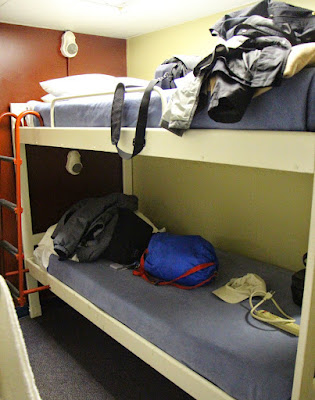 |
| Not luxurious, but practical |
Yes, they are transportation, not tours, but the views are unparalleled and I have seen many animals, including breaching whales, from the deck.
It is much cheaper than a cruise and a good way to get from place to place if you want to have your car (or a rental car) with you.
Do You Like Small Planes?
You can experience Alaska without going on a small plane, but you are cheating yourself out of some fabulous experiences. Many routine commercial flights are on small planes (19-seaters are common).
 |
| Top and right: Denali National Park; Bottom middle: Lake Clark National Park |
... floatplanes ...
 |
| Part of the fleet, The Farm Lodge, Lake Clark National Park |
... and (if you are lucky) tundra planes ...
 |
| Scott with our plane, Lake Clark National Park |
You get to see vast areas with NO civilization and have the thrill of landing on and taking off from lakes ...
... or sand bars ...
 |
| We just missed a Bear |
... vast expanses of tundra ...
 |
| Nothing as far as the eye can see |
... or hillsides populated by herds of Caribou ...
 |
| The biggest herd I have seen |
To find out how you can maximize the small plane experience, read about Lake Clark, Gates of the Arctic and Kobuk Valley National Parks in later installments of this blog.
 |
| Gates of the Arctic National Park |
If flying doesn’t interest you, maybe Alaska isn’t your thing! Sure, you can travel in Alaska without going on a small plane, I just don’t recommend it.
Do You Like Boats?
I suppose you could travel in Alaska without going on a boat, but why? I mean, Whales ...
... Orcas ...
 |
| Mama and baby Orca |
... Sea Otters ...
... Sea Lions ...
 |
| Steller Sea Lions |
... phenomenal scenery ...
 |
| Chiswell Islands |
... glaciers …
... Puffins (and lots of other birds) ...
 |
| Horned Puffin (you can also see Tufted Puffins) |
To see these, you must get on a boat ...
If you go to Alaska, you MUST go on a least ONE Whale watch. Frederick Sound, Pt. Adolphus and Auke Bay are all great and the Kenai Fjords boat tour usually produces some Humpbacks and/or Orcas (and once, we saw a Gray Whale).
 |
| On the ferry route to Juneau |
Since much of the boat travel is in the Inside Passage, Kenai Fjords or protected bays, the water is generally calm. However, traveling to Kodiak or the Aleutians can be a different story and, once, we did have some significant chop in Kenai Fjords National Park.
If you go to Alaska, you MUST go on a least ONE Whale watch. Frederick Sound, Pt. Adolphus and Auke Bay are all great and the Kenai Fjords boat tour usually produces some Humpbacks and/or Orcas (and once, we saw a Gray Whale).
 |
| Photographing a Humpback Whale |
 |
| Left: Kenai Fjords; Right: Glacier Bay |
Sea kayaking is fun (although I did get chased by a Steller Sea Lion once!). That was included on our cruises (the Inner Seas boat actually had a platform that lowered to smoothly launch and land kayaks).
 |
| The back of the ship is a kayak station |
I also love exploring via Zodiac, which is also usually part of small ship cruise activities and/or can often be booked as a separate tour. The danger of capsizing and/or getting soaked is much less. Although, in Alaska's climate, you must always be prepared to protect yourself from water.
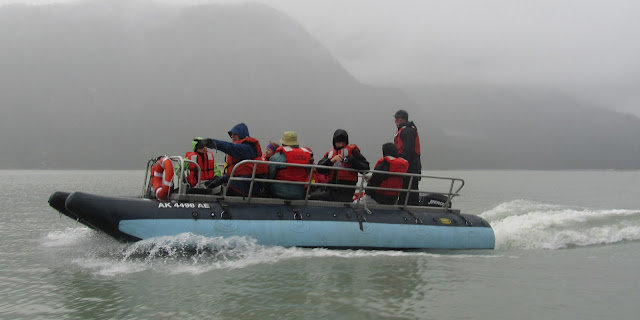 |
| A Zodiac adventure |
While on the water, we have seen great Orcas out of Juneau and Humpbacks in many places – Frederick Sound is a topnotch place to see them. Plus, I have seen Gray Whales, Dolphins, Porpoises, Sharks, Flying Fish, Jellies, Seals, Sea Otters and Sea Lions and lots of cool birds, including Puffins and Eagles. It is not uncommon to see Bears, Moose and Deer on the shore.
Do You Think "Bad" Weather Spoils a Vacation?
It rains a lot in Alaska, especially in the Inside Passage – that is why is it so green.
So, just plan on rain, fog, mist, but seldom heavy rain or lightning.
Plus, you can get some pretty cold weather, depending on where you are, even in summer.
 |
| A typical summer day in Kenai Fjords |
And, snow? It can happen.
 |
| September snow in Denali |
Don't be upset by precipitation, just rethink your position. The secret is to pack the right clothes.
 |
| The trade-off is drama |
 |
| Sleeveless! Photo: Scott Stevens |
When cruising, especially near glaciers, it can be very cool or even cold. I don’t take heavy jackets. Rather, I wear layers (because it can also be warm). Waterproof pants that will pull over your jeans or a pair of fleece pants are a must. I think I wore them every day on the cruise. Get the breathable type (REI and Bass Pro Shops carry them) or you’ll get very clammy.
Take thermal underwear (the silk kind) in case it gets too cool. Gloves and a hat are critical. I have a waterproof Aussie-type hat that I like because the brim prevents rain from hitting my glasses. Make sure it has a chinstrap (ships and ferries can be windy).
 |
| Dress for the locale (I think I have seven layers here) |
I also have a lightweight warm pullover, a jacket with a liner and a rain jacket big enough to fit over everything. I just layer lots of stuff when it is cold.
 |
| Sometimes ya gotta break rules |
As for shoes, there is lots of mud, so waterproof hiking boots are best. My cruise advised us to also bring waterproof boots like Wellingtons, but then actually provided them for us. They are great to have, so check to see if you need to bring your own. Wellies and the like are bulky to pack, so it's a bonus if the ship or lodge provides them.
 |
| It's about 40 below here; Left photo: Scott Stevens; Right photo: Hugh Rose |
Oh, don’t be fooled, though, interior Alaska can be very hot in the summer. I have encountered 80-90°F weather in Fairbanks and in Denali on at least two trips. Plus, unlike the Inside Passage, the interior is very dry.
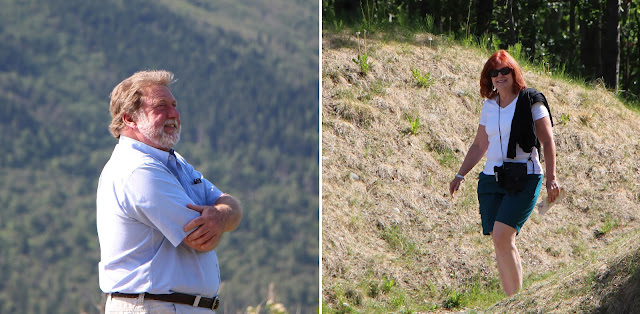 |
| A sunny day in Anchorage |
General rule of thumb – be prepared for anything and, the closer to the water, the cooler.
Also, if you are taking lots of short-hop planes, add in some buffer time to get to your destination. We have been fogged in/out in Anchorage, Brooks Camp, Gates of the Arctic, Gustavus, Juneau, Katmai, Kobuk Valley, Kodiak and Nome. Hotels tend to be very understanding if you can’t get there, but cruises and remote lodges can do only so much if you get delayed.
More to Come
In my next post, I'll talk about Alaska's eight National Parks.






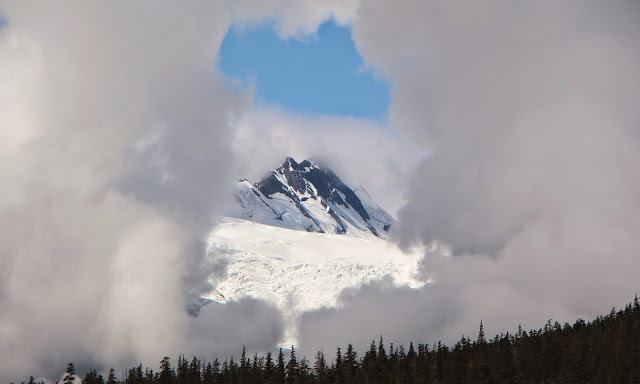













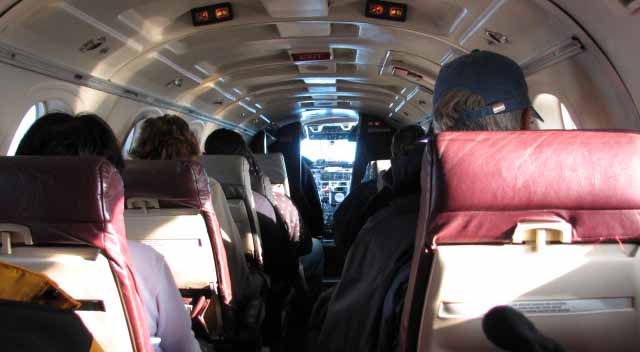








No comments:
Post a Comment